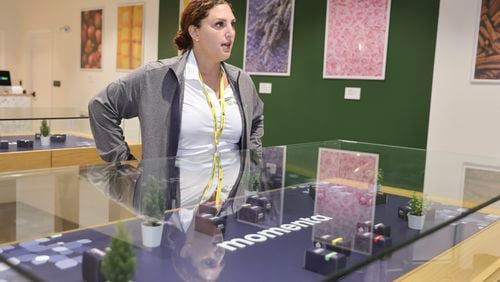About Arris Group
Headquarter: Suwanee area, in Forsyth County near the Fulton County border.
Other locations: Manufacturing primarily in Asia and Mexico, but also some operations in the Chicago area.
Employees: About 6,500, with hundreds based in metro Atlanta. Expects to grow to 8,500 employees worldwide with pending acquisition.
Growth: Bought Motorola Home from Google in 2013 for $2.35 billion. Recently agreed to acquire Pace Plc for $2.1 billion.
Revenue: $5.3 billion in 2014. Expected to reach $8 billion with closing of Pace acquisition.
What it does: Makes set-top TV boxes, modems and video gateways for inside homes. Most are sold to cable providers and telecom companies, which then provide them to subscribers. Arris also sells some in-home products at retailers. A big part of Arris’ business is producing system equipment for cable providers and telecoms.
Our home connections to the things we adore – TV and the online world – have turned into a messy digital Spaghetti Junction, with smart phones, tablets, high-def TVs, game consoles and more vying for airspace to get us more content faster.
Unnoticed by many, an equipment maker in Forsyth County has moved into the center of that hubbub, becoming one of the nation’s biggest providers of set-top TV boxes and other hardware that collects and sorts our in-home connections.
Arris Group operates from unspectacular, low-slung offices in the Suwanee area. But its client list includes household names like Comcast, AT&T, Verizon, Charter Communications and Time Warner Cable. It is gunning for more, hoping its gateway boxes will be the base that all others will connect to, whether they are Google or HBO.
Arris recently snagged some rare attention when it announced a $2.1 billion deal to acquire a top rival, United Kingdom-based Pace Plc. The deal, which needs shareholder and anti-trust regulatory approval, would be Arris's second $2 billion-plus deal in three years, following its purchase of Motorola Home from Google.
Already, Arris is North America’s biggest supplier of cable TV and cable data boxes, at about 50 percent of units sold last year. With Pace, that could jump to 65 percent.
“If you watch television or you use the Internet you are probably using an Arris product,” chairman and chief executive Bob Stanzione said. And yet, “the general public for the most part is not aware of Arris.”
The bulk of the company’s sales are to cable and telecom companies, not consumers.
“There are more and more ways for people to communicate,” Stanzione said. “There are more and more sources of information that people want instant access to. We are in the business of providing the solutions to those challenges.”
Consumers want options, yet have a hard time keeping track of the growing array of devices, connections and video feeds available to them, industry watchers say. Which remote am I supposed to be using? When do I change the input source?
"What they care about is simplicity," said Jeffrey Cole, who directs the University of Southern California's Center for the Digital Future. "What the American people want is transparency and ease."
Americans spend an average of $267 a month on communication devices that essentially didn’t exist in the marketplace two generations ago, Cole said. More are on the way. Plus there’s the promise of businesses making money with new ways to gather and combine personalized data on what consumers watch and read.
“You are going to see a lot of confusion. You are going to see a lot of new players because there’s a lot of money to be made,” Cole said. “It is going to be the Wild West for consumer services in the homes for awhile.”
Janna Anderson, who directs Elon University's Imagining the Internet Center, sees a battle to own home-based systems among a growing array of contenders
Layers and layers
First there are the companies that provide the pipes into our homes: cable firms like Comcast and Charter, plus traditional telephone giants like AT&T and, now, Google, which has committed to bring super-fast gigabit-per-second Internet and TV connections to some metro Atlanta homes.
Then there are add-on wireless boxes and USB plug-ins for streaming video, including Roku, Apple TV, Google Chromecast and Amazon Fire TV. Add to that programming services like Hulu, iTunes, Netflix and HBO Go. Then layer in the tidal wave of online devices that have become part of our daily lives: gaming consoles, tablets, smart phones, e-readers, lap tops, fitness bands, smart watches, plus the old-timers like TVs and desktop computers.
Now, consider the potential of the long-promised “connected home.” That’s where thermostats, lights, door locks, security systems, ovens, and heating and air conditioning equipment all become remotely controllable. Then there is the broader promise of an Internet of Things, where everyday items from milk jugs to shirts and alarm clocks could be wirelessly connected to serve our needs.
Arris aims to be the enabler, providing the equipment that collects and sorts some of the signals that all those other devices and services use.
It’s offerings in recent years have evolved from set-top TV boxes to what it calls gateways — boxes that can include stronger processors, powerful WiFi, modems and the ability to direct digital traffic in homes. Arris and other makers expect to allow more personalization of the streams, recommending different shows and services for different individuals.
Arris hopes to be part of much bigger leaps in the future.
Charles Cheevers, the company’s chief technology officer for home equipment, envisions a day when he might walk in his front door and the lights would automatically come on, his TV screen would say “Welcome home, Charles,” his favorite show would pop on, a message would assure him his blood oxygen level is good and he’d get a live feed from the security camera at the front door.
For consumers to buy into all that connectivity, Cheevers said, it has to be “really, really simple” for them.
What’s really useful?
Ellen Zegura is a Georgia Tech professor specializing in networking services, but don’t ask her to remember all the wireless devices in her home. In running down the list, she had to double check her recently purchased washing machine and dryer. It was labeled as having smart diagnosis capabilities.
“I’m not completely sure what that means,” Zegura admitted. “Until it breaks, I’m not going to worry about it.”
That ties into her broader thinking about the idea of a connected home that Arris and others want to be a part of, one filled with devices that talk to each other and can be accessed over the Internet.
“The big question is what are people going to find that will be useful?” she said.
On top of it all, American homes are becoming signal saturated from all those WiFi devices.
Arris leases a house in a subdivision near its headquarters. Stationed inside are a chorus of smart phones, tablets and other WiFi-connected devices propped on rotating turntables. The company’s engineers test whether the gateway boxes can handle the growing rush of signals. Otherwise, expect buffering and spinning rainbow wheels. Just the kind of thing we hate in the middle of House of Cards.







